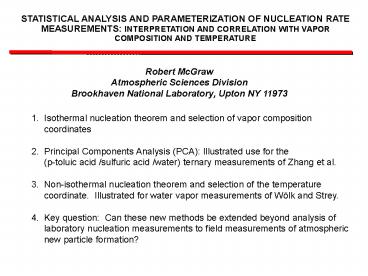Fate and Transport Modeling - PowerPoint PPT Presentation
1 / 15
Title:
Fate and Transport Modeling
Description:
Brookhaven National Laboratory, Upton NY 11973 ... (p-toluic acid /sulfuric acid /water) ternary ... Introduced application of PCA and exploited PCA/NT synergism ... – PowerPoint PPT presentation
Number of Views:59
Avg rating:3.0/5.0
Title: Fate and Transport Modeling
1
STATISTICAL ANALYSIS AND PARAMETERIZATION OF
NUCLEATION RATE MEASUREMENTS INTERPRETATION AND
CORRELATION WITH VAPOR COMPOSITION AND TEMPERATURE
Robert McGraw Atmospheric Sciences
Division Brookhaven National Laboratory, Upton NY
11973
1. Isothermal nucleation theorem and selection
of vapor composition coordinates 2.
Principal Components Analysis (PCA) Illustrated
use for the (p-toluic acid /sulfuric acid
/water) ternary measurements of Zhang et al.
3. Non-isothermal nucleation theorem and
selection of the temperature coordinate.
Illustrated for water vapor measurements of Wölk
and Strey. 4. Key question Can these new
methods be extended beyond analysis of
laboratory nucleation measurements to field
measurements of atmospheric new particle
formation?
2
ISOTHERMAL NUCLEATION THEOREM SINGLE COMPONENT
nucleation rate
const T
number conc. (vapor)
saturation ratio
number of molecules in critical nucleus
T250K
Example water vapor measurements of Wölk and
Strey, J. Phys. Chem. B105, 11683 (2001).
3
ISOTHERMAL NUCLEATION THEOREM MULTIPLE COMPONENTS
CORRELATING NUCLEATION RATE WITH VAPOR COMPOSITION
nucleation rate
const T, n1(j)
monomer number conc. species i in vapor
saturation ratio species i
number of molecules of species i present in
the critical nucleus
small kinetic term (between 0 and 1) related to
the direction of nucleation flux over the
cluster energy surface
4
ILLUSTRATION FOR A BINARY NUCLEATION RATE
Flux through critical saddle point region
illustrated for binary nucleation. From McGraw
and Wu 2003.
5
INTEGRATED FORM OF THE KINETIC NUCLEATION THEOREM
FOR MULTICOMPONENT NUCLEATION
logJ has strong propensity to be multi-linear
in coordinates logconcentration species(i)
1 component (e.g., water)
2 components (e.g., sulfuric acid/ water)
3 components (e.g., sulfuric acid/ organic acid/
water)
6
EXAMPLE TERNARY NUCLEATION INVOLVING AN ORGANIC
ACID
NT motivated replot on log-log scale
Data of Zhang et al., Science 304, 1487 (2004)
H2SO4 (109 molecule cm-3)
(a da 8.3) (c dc 1.7)
CRITICAL NUCLEUS MOLECULAR CONTENT (from slopes
or relative sensitivities ? Log J / ? Log Si )
H2SO4 8 molecules p-toluic acid 1
molecule!
7
PRINCIPAL COMPONENTS ANALYSIS (PCA)
N-theorem coordinates
Measurements (flexible data collection) xi, yi,
zi i 1,N
x Log10H2SO4, molecules cm-3 y
Log10Organic, ppb z Log10J, cm-3
centered coordinate vectors w(i) xi- mx, yi-
my, zi- mz i 1, N mx, my, mz is centroid
EIGENVALUES (sorted principal values) l1 gt
l2 gt l3 EIGENVECTORS (principal components)
v1, v2, v2
COVARIANCE MATRIX
principal coordinates
h1(i) w(i) v1 , etc.
8
COMPARING MEASUREMENTS IN THE PRINCIPAL FRAME AND
IN N-THEOREM COORDINATES
x Log10H2SO4, molecules cm-3 y
Log10Organic, ppb z Log10J, cm-3
Equation of plane (rotated to x, y, z coords)
9
PCA-BASED REDUCTION TO HOMOMOLECULAR
NUCLEATIONVIA THE AVERAGE VIRTUAL MONOMER
Kulmala and Viisanen, J. Aerosol Sci. 22, S97,
1991
Equation of line
slope
0.2 ppb p-toluic acid
0.4 ppb p-toluic acid
use actual concentrations
use reference concentrations (e.g. centroid of
data set)
10
NON-ISOTHERMAL NUCLEATION THEOREM SELECTION OF
THE TEMPERATURE COORDINATE
Kinetic extension of 2nd nucleation theorem
(McGraw and Wu, 2003)
Recommended form when only vapor composition is
known No bulk or equilibrium vapor
pressure information required!
Integration of recommended form gives structure
like the Clapreyron relation for vp (prefactor
tends to be constant in both cases).
Suggested temperature coordinate 1000/T
11
ANALYSIS OF SIMULATED WATER NUCLEATION
DATA (BASED ON AN EMPIRICAL FIT TO ACTUAL RATE
MEASUREMENTS)
Data and fit from Wölk and Strey, J. Chem, Phys.
B105, 11683, 2001
PCA fits captures T-dependence well but misses
small curvature and slope changes
220K
240K
250K
260K
curves from data set
PCA planar fit based on 200 simulated data
points entering random values for T and H2O
into empirical fit of Wölk and Strey
12
REGRESSION ANALYSIS OF RESIDUALS (INCLUDING
QUADRATIC TERMS)
h3 a1a2(h1)2 a3 h1 h2 a4(h2)2
220K
240K
250K
260K
quadratic in principal coordinates (greater
accuracy)
z - z(planar fit) b1b2 x2 b3 xy b4 y2
220K
240K
250K
260K
quadratic in original coordinates (more amenable
to physical interpretation)
13
EXTENSION TO ATMOSPHERIC NEW PARTICLE FORMATION
Our immediate goal is to build on this model,
incorporating the new multivariate nucleation
analysis based on the N-theorem described here,
and examine the sensitivity of 3nm and 10nm
particle formation rates to atmospheric
conditions.
McGraw and Saunders, Aerosol Sci. and Technol.
3, 367-380 This paper considers all of these
processes in an aerosol reactor study - with the
exception of coagulation loss of nano-particles
to background aerosol.
14
SUMMARY
Determined initiation mechanism for nucleation
in the ternary system p-toluic acid/ sulfuric
acid/ water directly from rate measurements (e.g.
a single p-toluic acid molecule is sufficient to
initiate the process). Introduced application
of PCA and exploited PCA/NT synergism for
analysis with flexible data acquisition.
Developed compact NT-based parameterizations for
nucleation rate in terms of vapor composition
and temperature (source term for new particle
formation). Modification of second
nucleation theorem to work directly with species
concentrations rather than supersaturation.
Long term goals Support interpretation of
laboratory and ultimately - when aerosol is
included - field measurements. Improve
capability for prediction of new particle
formation in climate models.
15
ACKNOWLEDGEMENTS
Renyi Zhang for sharing data and
collaborations on the N-Theorem/PCA data
analysis and interpretation for the ternary
system. The DOE Atmospheric Science Program
for support.

